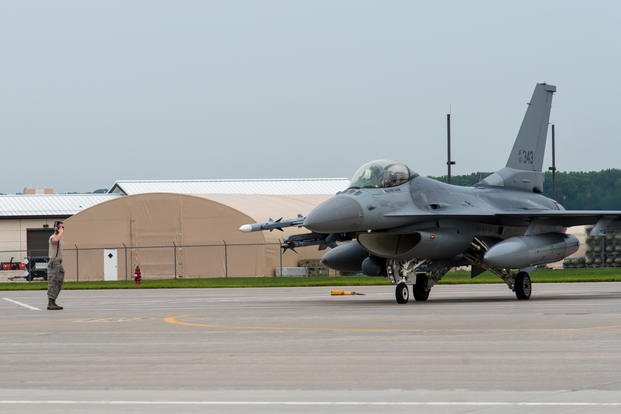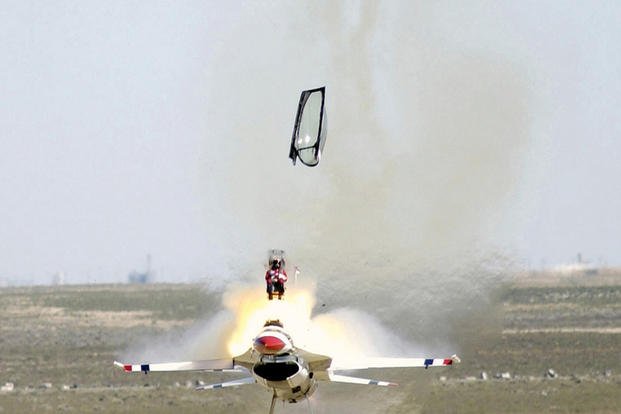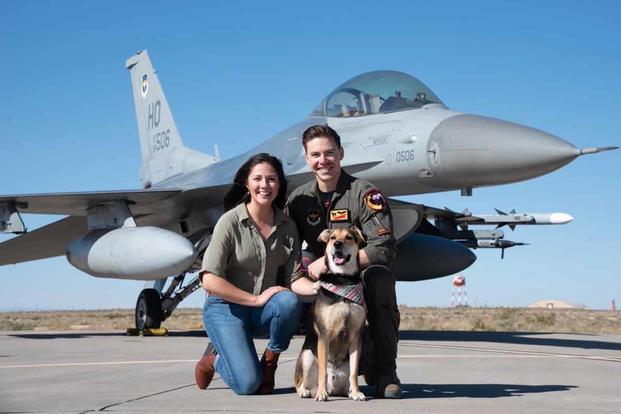Editor's note: This is the second of a two-part series about the fatal accident of 1st Lt. David Schmitz, an F-16 pilot at Shaw Air Force Base, South Carolina. Read the first story: F-16 Pilot's Runway Death Forces Reckoning Over Tight Flight Hours, Training Gaps
There was no shortage of missteps, accidents and bad calls that led to the crash that killed F-16 pilot 1st Lt. David Schmitz last June: A botched risk assessment that didn't consider his level of experience for the mission that night, his damaged landing gear, and an improper suggestion from the control tower to attempt a cable arrest while landing with his busted gear.
Despite all that, Schmitz might have had a chance at walking away from that crash but for one devastating problem: A catastrophic malfunction of his ejection seat when he tried to bail out as his landing was going all wrong.
A full year later, Schmitz's widow, Valerie Rudolph, is left with nothing but questions. Why was Schmitz given the all-clear to land with his damaged landing gear? Would he have survived if not for the ejection seat, which malfunctioned as Schmitz attempted to bail out instead as his final act?
Valerie isn't alone. Fellow pilots' spouses close to the Schmitzes and the rest of the Schmitz family have voiced similar questions. And Military.com readers, some of them retired maintainers, also wanted to know why such an egregious failure was allowed to happen with the ejection seat, a mechanism that literally means the difference between life and death to the pilots who use it.
"I just can't believe that one seat had that many separate and unique failures," said one former maintainer who worked on fighters and bombers in the Air Force for 20 years. "Seems like they would have grounded the fleet."
According to data and corresponding information provided to Military.com, the Air Force did not see a need to hasten inspections or accelerate maintenance on the seat's sequencer, because work was already underway. But changes came too late for Schmitz. And even after the tragedy, no comprehensive fast-track has been ordered. While parts from the same production line as Schmitz's seat have been sidelined, it's not certain whether another ejection seat mishap could happen before maintenance work is complete.
It’s something Schmitz's widow fears -- that another pilot may suffer the same fate.
On the night of the fatal accident, members of the 77th Fighter Squadron at Shaw Air Force Base, South Carolina, involved in the training mission incorrectly filled out Schmitz's risk management worksheet, which estimates the amount of hazard before an event, evaluating factors such as experience, weather and other conditions. The scenario was a nighttime air-to-air refueling from a KC-135 Stratotanker and a suppression of enemy air defense simulation, the first time Schmitz had done either of those training exercises.
The risk factors should have been rated higher based on his experience, and would have been elevated to the operations group commander or designated counterpart for additional approval. Because of the miscalculation, that didn't happen, according to the Accident Investigation Board report's findings, released in November.
Coming in for a landing, Schmitz, 32, severely damaged the aircraft's landing gear upon touching down, striking an antenna array short of the runway. He attempted a cable arrest with the busted gear, as instructed -- improperly -- by personnel in the control tower.
Schmitz slammed into the ground while still in his ejection seat due to a sequence malfunction. He died instantly.
Shaw officials say those involved in the June 30, 2020, event have been disciplined.
"Over the past year, we have examined and revised our policies and processes in the [wing] in order to help prevent an accident like this from happening again," Col. Lawrence Sullivan, commander of the 20th Fighter Wing at Shaw, told Military.com.
"Leadership also reviewed the accident investigation board report and has taken multiple administrative actions to hold responsible individuals accountable," he said, adding that the administrative actions are covered by the privacy act and cannot be released.
Valerie believes the Air Force should have done more.
"I just feel like the response was, 'Whoops, sorry about that,'" she said. "Why did he get put in this situation in the first place? That's not minimizing risk, that's allowing the possibility of risk to take place.
"I hope changes are being made. At the end of the day, that ejection seat should have worked," Valerie added. "I feel really let down. I'm just so sad for him."
The Ejection Misfire
Calling for a comprehensive stand-down would have been a colossal undertaking since the ACES II ejection seat is used by multiple fleets: the F-16 Fighting Falcon, F-15 Eagle and Strike Eagle, F-22 Raptor, A-10 Thunderbolt II, B-1 Lancer and B-2 Spirit. By the service's calculations, that's 2,532 ACES II seats, made by Collins Aerospace of Raytheon Technologies, according to data provided to Military.com. Collins referred all questions to the service.
The essence of the mechanism is a small computer that makes sure that the sequence of events in a seat launch happens in the correct order, said the former maintainer. Because the ejection process needs more than a dozen minuscule but critical items to launch in succession, "the upgrade to the sequencer is so important," the maintainer added.
Normally, when the seat exits the aircraft, "the Digital Recovery Sequencer (DRS) is activated, which is responsible for providing seat stabilization, pilot/seat separation, and parachute deployment," the investigation report into Schmitz's mishap states.
The system normally fires signals to multiple pyrotechnic devices, which execute the ejection sequence. In Schmitz's case, six pyrotechnic devices should have fired, "yielding a parachute in less than two seconds."
But the devices did not fire, and the parachute did not deploy. Schmitz had only 3.4 seconds after initiating ejection to pull the emergency manual parachute deployment handle once he realized the first hadn't worked. The Accident Investigation Board president, Maj. Gen. Randal Efferson, found that it was "possible, but highly unlikely" Schmitz could have done so in that timeframe, especially if incapacitated by disorienting events.
Air Force Research Lab inspectors who aided in the investigation found that there were errors in two of the DRS's three control channels: Channel two failed due "to a critical error at power-on, and channel three failed due to a signal noise issue," the report states.
The service said that the issue has "been observed in approximately 9% of all live ejections and sled tests," for the seat, the report adds.
The DRS was introduced in 2005, with the final systems procured in 2014 from California-based Teledyne Electronic Safety Products.
The errors in Schmitz's case -- at the power-on and a signal noise issue -- can happen to a variety of electronic equipment, said a longtime military aviation specialist, who asked not to be identified because he is not authorized to speak to the press in his current job.
A modification could have averted one or both of those issues, said the specialist, echoing what Efferson determined in his report findings. The flaw would have been found within a Time Compliance Technical Order, known as a TCTO maintenance inspection.
That type of inspection often mandates expedited modifications, comprehensive equipment inspections or installation of new equipment in order to fix an urgent issue or reduce a potential hazard.
The first opportunity for the TCTO would have been in 2017, Efferson said. But it was not executed because of "lack of available parts."
"The TCTO requirement was automatically deferred to the next 36-month seat inspection, which was 28 August 2020," approximately eight weeks after the accident, according to the report.
The DRS in Schmitz's seat was considered "expired" in February 2019. Knowing this, the Air Force Life Cycle Management Center approved an extension, independent of the TCTO requirement, until parts were available. The center issued three extensions, the last approved on May 27, 2020, that would have expired on July 31.
"When it comes to things that are life support, i.e. an ejection seat or an oxygen [breathing] system, those are things that you've got to think really long and hard before you defer those [maintenance orders]," said retired Gen. Herbert "Hawk" Carlisle, an F-15 Eagle pilot who led Air Combat Command between 2014 and 2017. "I mean, it's your last resort."
To correct the noise-related deficiency, the service chose to fine-tune the DRS with a shorting plug or replace the DRS entirely with an upgraded sequencer, known as the Modernized ACES II Seat Sequencer, or MASS, depending on the age of the respective unit, according to the Air Force Safety Center.
Schmitz's F-16 was scheduled to receive an upgrade to MASS, also made by Teledyne. The aircraft would have received maintenance between July 8 and Aug. 21 for the MASS installation, canceling out the TCTO requirement.

When asked whether the Air Force Life Cycle Management Center -- which had issued multiple extensions on the fix -- decided to ramp up spare parts deliveries to bases after the accident, officials said no.
The shorting plugs and or MASS devices "were provided to Air Force bases as they became available," for those aircraft still requiring the tech order completion, said Derek Kaufman, spokesman for Air Force Materiel Command, which oversees the center.
If MASS assets were available instead of the shorting plugs, they "were delivered to bases for installation to minimize future maintenance actions," he said. No other spare parts were required to complete these TCTO actions, he added.
"There should be no excuse ever for lack of available parts, especially critical parts," Valerie Rudolph said.
The DRS has a shelf life of 10 years; it is no longer manufactured, the service said.
Rep. Ken Calvert, a California Republican who has been in touch with the Schmitz family, told Military.com that the service needs to review its protocols for maintenance extensions.
The Air Force must "determine the root cause of parts shortages that prevent critical life-saving maintenance and work with Congress to fix it," Calvert said.
Aircraft Still Need of Repair
Aside from the accident at Shaw, there have been no other aircraft accidents within the last five years in which the DRS issue caused a seat separation to fail, the Air Force Safety Center said.
But there was another incident that occurred earlier, which became the catalyst for the all-inclusive TCTO inspection.
In 2014, an F-16C instructor pilot in the Tulsa Air National Guard experienced a similar DRS failure during an uncontrolled ejection near Moline, Kansas, after he and his student pilot collided during a training mission. In that case, the instructor pilot was more experienced than Schmitz, with more than 2,600 flight hours. Within 4 seconds, the pilot, unnamed in the report, knew he had to pull the emergency manual parachute deployment handle, and did so at 7,500 feet above ground. Like Schmitz, circumstances called for a Mode 1 ejection, or an egress for speeds less than 250 knots and altitudes less than 15,000 feet, for which the drogue parachute -- the subsequent chute -- doesn't deploy.
Both pilots survived in that incident.
The service did not see a reason to ground fleets following Schmitz's incident since the TCTOs -- ordered in 2016 following the 2014 incident -- were already underway, the safety center said.
"Comprehensive testing of components up to now has generated nominal data on performance to specification and supported the decision to keep flying," the center said.
It was still enough to give some leaders pause.
Word came from higher headquarters and Air Combat Command, or ACC, to stand down those aircraft that had seats from the same production lot, according to Sullivan, commander of the 20th Fighter Wing at Shaw.
ACC found that 19 seats shared the same sequencer from the same production line as Schmitz's, 14 of which had received an upgrade to the MASS.
That meant five seats were removed from service: two F-16 seats, two F-22, and one F-15 Strike Eagle. The five were immediately replaced with MASS units, the Air Force said, without disclosing which units were involved.
In March, the service said it had 1,321 seats that have the DRS sequencers with shorting plugs, while 1,096 have MASS. Twenty seats were not accounted for in the data "due to long-term repairs, condemned status" or other factors; those seats "will not fly until completed," officials said in an email.
As of April 8, seats from 32 aircraft were still waiting to receive the plug upgrade or full transfer to MASS by the end of September.
The service did not disclose which aircraft are affected, or how often these aircraft are flying while awaiting scheduled repair.
During the operational stand-down that occurred following Schmitz's death, Sullivan said he learned there were some "knowledge gaps" in the pilot community at the base about when to pull the ejection seat handle for a controlled and straightforward ejection.
"None of our F-16s flew again until each of the pilots had been retrained in that specific area," he said.
Lack of Confirmation
Schmitz knew he was in trouble after he clipped his landing gear on his final approach to the runway. He made contact with the antenna because he incorrectly "interpreted the approach lighting system [to] identify the runway threshold," according to the report.
The hit damaged the landing gear, caused its wheel to rotate perpendicular to the direction of travel and split its hydraulic lines, creating a failure in its secondary "system B" hydraulics, which control the power to the landing gear, nose wheel steering and wheel brakes, among other actions.
Schmitz spoke with the supervisor of flying, or SOF, in the control tower, as well as the mission instructor lead, about follow-on procedures. The SOF told him that an ejection might be required "if conditions are not favorable."

Personnel in the control tower and the mission lead eventually determined that Schmitz should follow the guidelines laid out in the "Landing with a Landing Gear Unsafe/Up" checklist and that he should attempt an approach-end cable arrestment, meaning that the F-16's tailhook would be caught by a steel cable on the runway.
But Schmitz was hesitant, calling to the control tower not once, but three separate times asking whether it was the best idea. The report noted the supervisor, unnamed in the report, should have consulted with Lockheed Martin safety engineers for technical assistance to determine if the move was executable. That call did not happen. The supervisor also did not directly address Schmitz's questions, according to the report.
Carlisle, the former ACC commander, said this should have been an immediate red flag.
"You know that you're going to reach out and call and do everything you can to prepare for whatever contingency you're dealing with," Carlisle said, adding that when this failed for Schmitz, the young pilot likely went into an immediate reaction mode.
"You're making instantaneous decisions," he said. "A lot of experience makes those instantaneous decisions. You aren't necessarily thinking, you're reacting."
When Lockheed, the F-16's manufacturer, was consulted following the accident, engineers said that that particular checklist "only applies if a landing gear fails to extend normally, not when it is damaged or hanging." The engineers determined that the outcome of an attempted cable arrestment was unknown in Schmitz's case; however, they were aware of two previous instances of a damaged landing gear similar to his. In both cases, an ejection was suggested and performed instead.
Calvert, the congressman, said the Air Force should ensure the supervisors of flying review procedures to listen to pilots under duress.
Their input is crucial, as well as recommendations from the aircraft manufacturer, he said.
The Final Moments
Valerie Rudolph knows her husband never backed down from a challenge. He was a distinguished graduate, won multiple awards, and kept cool even when everything went wrong.
"I've heard the tape," Valerie said, referring to Schmitz's exchange with the control tower. "Even after landing short, he's flying in the air and he's still incredibly professional. He was focused. I don't think he knew he was about to die."
For any Air Force pilot in the middle of a situation that calls for an uncontrolled ejection, "you'd love to be 5,000 feet above the ground level," Carlisle said.
Schmitz's F-16 touched down after traveling approximately 1,108 feet and at 138 knots ground speed and immediately veered left, indicating that the left main gear had failed to support the weight of the aircraft.
The left wing hit the runway. Schmitz then activated the ejection seat, but to no avail.
"I've been along on this journey for Dave, and I knew what his dream was, and I've been along this crazy road," Valerie said. "He achieved his dream, he reached his goal, in a sense, but he didn't really get to fully live his dream.
"He was professional the entire time. Until the very end," she said.
-- Oriana Pawlyk can be reached at oriana.pawlyk@military.com. Follow her on Twitter at @Oriana0214.
Related: After Fatal Jet Crash, the Pilots Got Blamed. Then the Air Force Banned the Flight Maneuver











